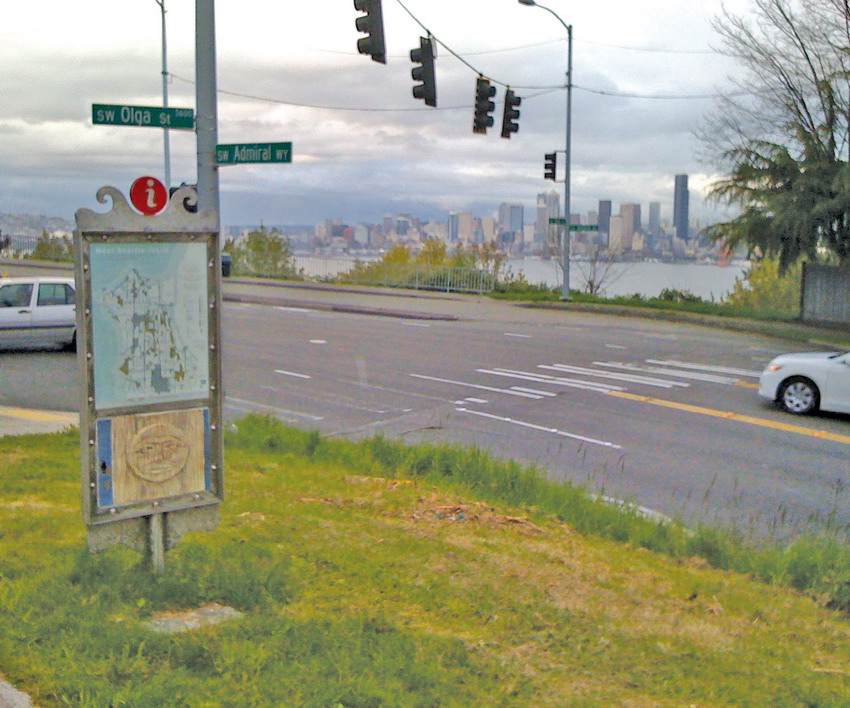Seattle’s denizens have historically embraced any initiative deemed “green” or “sustainable.” Naturally, this mindset filters down to its signage. To create a pedestrian-friendly, wayfinding system, Feet First, a Seattle-based organization that promotes walkable communities, applied for a City of Seattle Dept. of Neighborhoods grant to develop a series of wayfinding kiosks and wayfinding signs that help visitors and new residents navigate West Seattle, a suburb with approximately 50,000 inhabitants.
The department bestowed approximately $100,000 from the Dept.’s Neighborhood Matching Fund (Feet First also procured funding from the National Parks Service and the Robert Wood Johnson Foundation to assist with project planning), and the organization worked with representatives from nine West Seattle districts to develop the system. After approximately two years of discussions with local officials who represented various city, county and state departments, Feet First developed a plan for the kiosks.
The organization created large walking maps – displayed at kiosks with close-ups of the neighborhood where the kiosk is located. The kiosks also include a ceramic-tile mosaic with artwork that reflects a building, animal or other icon reflective of the neighborhood, and a magnetic area where community announcements can be posted.
After having executed a request for proposals, Feet First enlisted Paul Sorey, a West Seattle sculptural artist and metalworker, to fabricate the kiosks. Mike Raney, a local designer, also assisted with the mosaics’ conceptual design.
After having developed the renderings using AutoCAD® drafting software, he fabricated the kiosks from 3⁄8- and ¼-in.-thick, stainless steel via MIG welding. Sorey used a grinder to set to make a patterned, textured finish on the metal.
“We want the signs to be robust,” he said. “There are a lot of architectural signs that don’t hold up well over time. Also, stainless steel allows you to mount below ground, so your footings aren’t exposed.”
After having core-drilled 14-in.-deep holes, Sorey dug 3 ft. deep under the sidewalks with a hand auger before he installied rebar and a concrete footer to support the signs. He fired the ceramic tiles in his own kiln and red medallions on each kiosk’s crest were painted with Matthews acrylic-polyurethane paint.
Advertisement
Signs of Seattle (Georgetown, WA) printed the integral maps – two were printed per kiosk, one general map and one with a close-up view that reflects the neighborhood – using Arlon vinyl on the shop’s Mutoh ValueJet 1614 printer with eco-solvent inks. To protect the maps, the shop applied Arlon’s 10-year, 2-mil, 3350 anti-graffiti overlaminate. The prints were subsequently applied to 3A Composites’ 6mm Dibond® composite material.
“Feet First didn’t have strict material stipulations, so we were free to use the materials we thought would best accommodate the job,” Cordelia Loudon, a Signs of Seattle sales rep, said. “And, cooperation was terrific with all parties involved on the project, which usually creates an ideal end result.”
To complement the wayfinding kiosks, and as part of the Dept. of Neighborhoods grant, West Seattle’s in-house signshop is also developing a series of 86, painted-aluminum wayfinding signs that will be secured to road signs throughout West Seattle.



 Photo Gallery2 weeks ago
Photo Gallery2 weeks ago
 Paula Fargo2 weeks ago
Paula Fargo2 weeks ago
 Real Deal1 week ago
Real Deal1 week ago
 Photo Gallery2 weeks ago
Photo Gallery2 weeks ago
 Projects1 week ago
Projects1 week ago
 Business Management1 week ago
Business Management1 week ago
 News1 day ago
News1 day ago
 News1 week ago
News1 week ago







